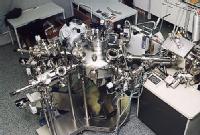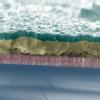Pulsed Laser Deposition (PLD)
Pulsed Laser Deposition (PLD) is a powerful, yet simple technique for the generation of ‘thin films’ of material onto suitable substrate (base or foundation) materials.
 How does it work?
How does it work?
PLD works by directing a powerful pulsed ultra-violet laser at a target material which has the same material and desired composition desired of the resulting thin-film.
Pieces of material are ‘ablated’ off the target material then caught by an appropriate substate material positioned close to the target.
Due to precise control of the laser power and pulse-rate and a number of measurement techniques integral to the PLD such as AFM, it can be a very precise technique for the growth of thin films – some only a few atoms thick – in a controlled manner.
Applications:
Pulsed laser deposition (PLD) is a versatile technique.
In general the transfer of a material of similar composition between target and substrate allows depositing all kinds of different materials including: high-temperature superconductors; oxides; nitrides; carbides; semiconductors; metals; polymers; fullerenes.
The preparation in an inert gas atmosphere also makes it possible to tune the thin film properties (stress, texture, reflectivity, magnetic properties) by varying the kinetic energy of the deposited particles.
Sample handling requirements:
Small (<150mm) substrate material required. Small (<150mm) example of target material to be ablated required.
Complementary techniques:
MBE, Sputtering, Single Crystal Growth
Warwick Capability:
TSST BV UHV PLD with integral (in-situ) AFM, STM, RHEED and XPS
Contact:
Claire Gerard: c dot gerard at warwick dot ac dot uk / 07385 145064
Typical results format, and sample:
Status |
Availability |
| Warwick collect/analyse data | |
| Warwick collect data | |
 |
Available to user with expertise/ contribution |
 |
Spare capacity for collaborative research |
BOOK NOW |



